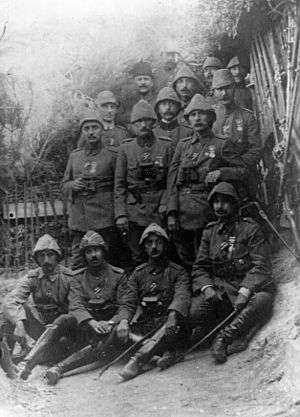Seventh Army (Ottoman Empire)
The Ottoman Seventh Army was a large military formation of the Ottoman Empire in the late 19th and early 20th centuries. Although designated as an army, at least by 1918, it was only of corps strength.
| Seventh Army | |
|---|---|
 Commander and men of III Corps, 1915 | |
| Active | 1877–? August 12, 1917[1] – November 7, 1918[2] |
| Country | |
| Size | Effectively corps (although named as an army) |
| Part of | Yildirim Army Group |
| Engagements | Sinai and Palestine Campaign (World War I) Battle of Megiddo |
| Commanders | |
| Notable commanders | Mustafa Kemal (July 5 – October 9, 1917) Fevzi Çakmak Paşa (October 9, 1917 – August 1918) Mustafa Kemal (August 7 – November 7, 1918) |
The Seventh Army was established in 1877 for service in Arabia and the Yemen.[3] By 1908 it consisted of the 13th and 14th infantry divisions, one cavalry regiment and one artillery regiment[4] and they were involved in combatting insurgent tribesmen in the Yemen.[5]
World War I
Order of Battle, August 1917
In August 1917, the army was structured as follows:[6]
- Seventh Army, Syria (Mirliva Mustafa Kemal Pasha)
- III Corps
- 24th Division, 50th Division
- XV Corps
- 19th Division, 20th Division
- German Asia Corps
- III Corps
In late 1917, commanded by Fevzi Pasha, the Seventh Army was ordered to advanced across the desert in order to bring pressure to bear upon Allenby's inland flank in Palestine. While Allenby attacked the Ottoman Eighth Army, his Australian Mounted Division was sent to hold back the advance of the Seventh Army. The Seventh Army did manage to force the Australians to retreat by several miles but ultimately the Australians held their line. After the British victory in the Battle of Mughar Ridge on 13 November (which did not directly involve the Seventh Army), Fevzi decided to withdraw the Seventh Army to guard Jerusalem.[7]
Order of Battle, January 1918
In January 1918, the army was structured as follows:[8]
- Seventh Army (Mirliva Mustafa Fevzi Pasha)
Order of Battle, June 1918

In June 1918, the army was structured as follows:[9]
- Seventh Army (Mirliva Mustafa Fevzi Pasha)
Order of Battle, September 1918
In September 1918, the army was structured as follows:[10]
- Seventh Army (Mirliva Mustafa Kemal Pasha)
- III Corps (Miralay İsmet Bey)
- 1st Division, 11th Division
- XV Corps (Miralay Ali Fuat Bey)
- 26th Division, 53rd Division
- III Corps (Miralay İsmet Bey)
The Seventh Army was destroyed by British aerial bombardment during its retreat from Nablus on 21 September 1918.[11]
After Mudros
Order of Battle, November 1918
In November 1918, the army was structured as follows:[12]
- Seventh Army (Mirliva Ali Fuat Pasha, deputy)
References
- David Nicolle, colour plates by Rafaelle Ruggeri, The Ottoman Army 1914-18, Men-at-Arms 269, Ospray Publishing Ltd., 1994, ISBN 1-85532-412-1, p. 15.
- Zekeriya Türkmen, Mütareke Döneminde Ordunun Durumu ve Yeniden Yapılanması (1918-1920), Türk Tarih Kurumu Basımevi, 2001, ISBN 975-16-1372-8, p. 30. (in Turkish)
- Erickson, Edward J (2003). Defeat in detail: the Ottoman Army in the Balkans, 1912-1913. Greenwood Publishing Group. p. 6. ISBN 0-275-97888-5.
- Erickson, Edward J (2003). Defeat in detail: the Ottoman Army in the Balkans, 1912-1913. Greenwood Publishing Group. p. 17. ISBN 0-275-97888-5.
- Erickson, Edward J (2003). Defeat in detail: the Ottoman Army in the Balkans, 1912-1913. Greenwood Publishing Group. p. 19. ISBN 0-275-97888-5.
- Edward J. Erickson, Order to Die: A History of the Ottoman Army in the First World War, Greenwood Press, 2001, ISBN 0-313-31516-7, p. 170.
- http://www.firstworldwar.com/battles/mugharridge.htm
- Edward J. Erickson, Order to Die: A History of the Ottoman Army in the First World War, Greenwood Press, 2001, ISBN 0-313-31516-7, p. 181.
- Edward J. Erickson, Order to Die: A History of the Ottoman Army in the First World War, Greenwood Press, 2001, ISBN 0-313-31516-7, p. 188.
- Edward J. Erickson, Order to Die: A History of the Ottoman Army in the First World War, Greenwood Press, 2001, ISBN 0-313-31516-7, p. 197.
- "Archived copy". Archived from the original on 2012-10-12. Retrieved 2012-10-29.CS1 maint: archived copy as title (link)
- Edward J. Erickson, Order to Die: A History of the Ottoman Army in the First World War, Greenwood Press, 2001, ISBN 0-313-31516-7, p. 202.